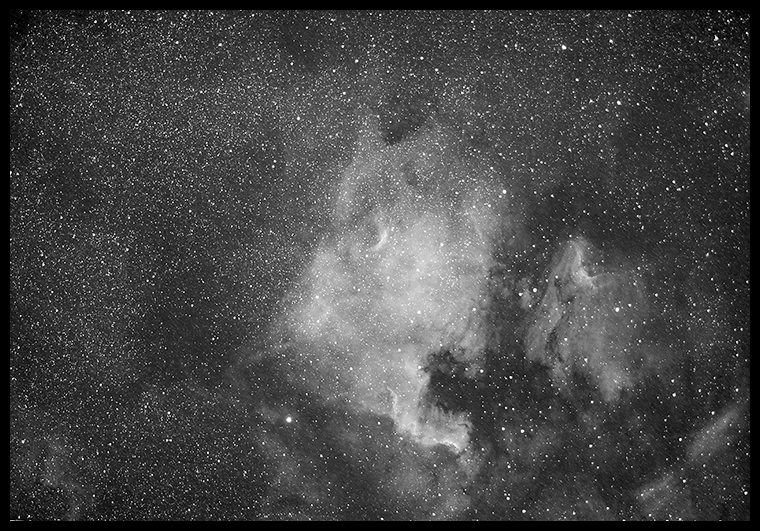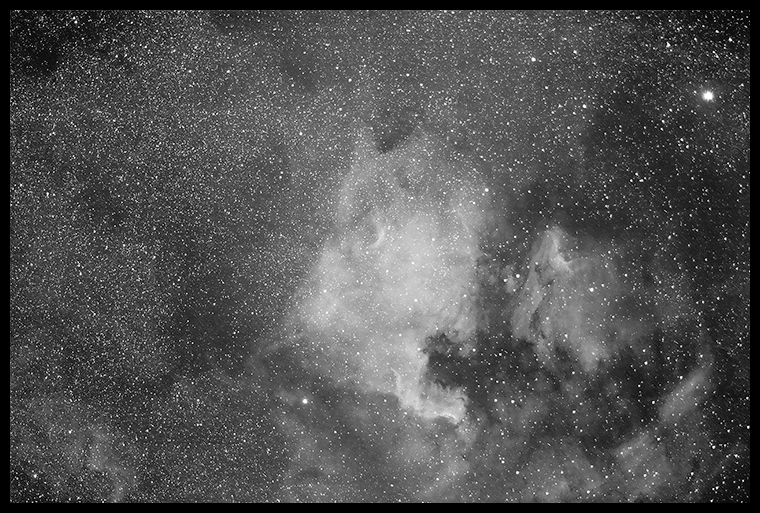10/20/2013. I had Hap Griffin modify my 50D to extend its red sensitivity. He replaced the stock IR-blocking filter with an AstroDon filter with excellent transparency deep into the red end of the visual spectrum. I shot a custom white balance frame and used it normally while awaiting clear skies. Works nicely. So Hap replaced the stock filter to pass hydrogen-alpha light; for tonight's photos, I fitted the camera with a secondary clip-in filter that passes only hydrogen-alpha light.
When using the camera for narrow-band H-a imaging, it's really better to reset the white balance to daylight before putting the camera to work under the stars (else the blue and green channels are boosted relative to the red channel, and with the H-a filter in place, that can only increase noise in the finished images). Last night, I neglected to do this, but saved most of the advantages by resetting to daylight white balance while converting the CR2 files to downsized tiffs prior to stacking. Maxim can actually extract the red Bayer plane, tossing all the blue and green noise at a stroke, but I've yet to figure out how to do that in batch mode.
This crisp October night one day past full Moon, I took aim at NGC 7000:

NGC 7000 & neighbors
24x180s
200mm F2.0, 12nm H-a
Canon 50D-HG, iso 1600
(Click the image for a larger version.)
I was actually disappointed with that result last night. Go figure: no flats, no darks, no guiding, only 72m of total exposure at the wrong white balance, with the Hunter's Moon shining in the east, and I still got that! Darks would be particularly useful -- the drifts of stars can be kept much cleaner if they are not fighting to rise over drifts of noise; shifting the color balance to daylight in post-proc was important.
After downesampling the huge CR2 files to 2400-pixel 16-bit Tiffs (and renormalizing the Bayer mix to daylight specs), I aligned and stacked the resulting smaller files in MaximDL and used Photoshop levels and curves to finish.
The 50D's live view feature doesn't work particularly well (or maybe at all) with the 12nm clip-in H-a filter (human eyes just barely work at this wavelength) even with the camera aimed at Vega. I ended up refining the focus using a Bahtinov mask (same one that fits the 5-inch A-P) and 10s expsoures. Stars are slightly funky and the sensor is likely not perfectly normal to the optical axis. Try closing the aperture a little more, maybe all the way to F2.8. And check the screws at the aft end under the el cheapo Nikon-EOS adapter. As I recall, things clean up dramatically when the full aperture isn't needed. Shims, anyone?
The 50D has Magic Lantern software installed. It should be able to do this kind of sequence using its internal intervalomater rather than depending on an external timer. But Magic Lantern's options and parms are complex, and I need to practice before relying on it under the stars, so I used the trusty timer afterall. Here's the kit for the night including a close-up of a really good starting point for focus with the clip-in H-a filter:

Focusing is aided by a micrometer head strapped to the focus ring of the 200mm F2.0 (I used J.B. Weld and a muffler clamp). It takes a good twist or two of the micrometer to turn the focus barrel by the width of the index line. Much less twisting than that is readily visible in the pattern drawn by the Bahtinov mask. The downside is that I don't have any excuses for missing focus.
Yes, as a matter of fact, we have been down this road before, way back in 2009. This time I'm bringing to the project better tracking, more experience, and a better camera (though the 20D Hap modified is no slouch). I thought I had a good photo of the micrometer arrangement already posted somewhere. Anyway, while I look for it, here's a brief trip through the wayback machine:
November 14, 2009
November 27, 2009
10/22/2013. Farmville takes more effort. Look, to have Maxim "manually" extract the red plane and save the resulting image made up of all and only pixels under the red filters in the Bayer matrix takes only a couple of clicks. Do it for two dozen images, and you still don't have more than a minute invested. An all-night session's take will require, maybe what, five minutes? Just do it. It takes more clicks than that to harvest a small plot of jewel encrusted fairy goat beard whiskers or whatever in Farmville. The much smaller images keep all the live data at full resolution and process much faster, too. Look:

NGC 7000 & neighbors
24x180s (Red plane isolated)
200mm F2.0, 12nm H-a
Canon 50D-HG, iso 1600
(Click the image for a larger version.)
I don't know for sure whether the difference is apparent here on the web, but it's clear when working with the full-resolution imagery that the noise in the darker areas is dramatically reduced compared to the images presented earlier. Eventually, I'll automate some of this. But in the meantime, just harvest the damn pixels.
One difference is that the second set of images uses the entire chip; I did not crop out Deneb and its chromatic mess. By and large, star images are much cleaner. I wonder if there's more to this than simple optical aberration. Is light slipping out of the red pixels to pollute adjacent ones somehow? Is that even possible?
Except where noted, deep-sky photos are made with an SBIG ST2000XM CCD behind a 10-inch Astro-Tech Ritchey-Chretien carried on an Astro-Physics Mach1GTO. The CCD is equipped with Baader LRGB and 7nm H-a filters. The internal guide chip of the CCD most often keeps the OTA pointed in the right direction (I'll let you know when a Meade DSI and a separate OAG or guidescope takes its place). Camera control and guiding are handled by Maxim DL 5.12. The stock focuser on the AT10RC has been augmented with Robofocus 3.0.9 using adapters turned on the lathe downstairs. Maxim performs image calibration, alignment, and stacking; Photoshop CS4 and FocusMagic 3.0.2 take it from there. Gradient Xterminator by Russell Croman and Astronomy Tools by Noel Carboni see their share of work, too. Beginning in May 2013, PixInsight has taken over some of the heavy lifting for transfer function modification and deconvolution.
:: top ::